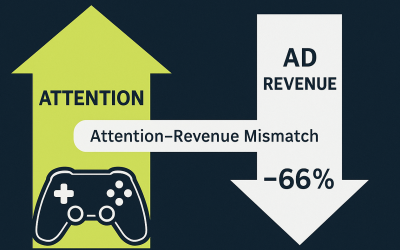Strategies to Optimize Rewarded Video Monetization
Rewarded video ads are a powerful tool in the world of digital monetization. They allow users to watch an ad in exchange for something valuable, like in-game currency, premium content, or exclusive features. This value exchange creates a win-win situation: users engage with ads voluntarily, and you generate revenue.
However, merely implementing rewarded video ads doesn’t guarantee success. Like any other ad strategy, maximizing its potential requires thoughtful optimization. If you want higher engagement, better completion rates, and increased revenue, you need to fine-tune your approach.
In this guide, we’ll cover five essential steps to optimize your rewarded video strategy for better performance.
Contents
Strategy 1: Know Your Audience
Continuing on my Strategies to Optimize Rewarded Video Monetization Post, understanding your audience is critical to delivering a successful rewarded video ad experience. To truly optimize your rewarded video strategy, you need to know who your users are, what they value, and how they interact with your app or website.
Start by gathering data on user behavior. Analytics platforms like Google Analytics, Firebase, and Amplitude can provide valuable insights into your users’ demographics, habits, and preferences. For example, are your users primarily gamers? If so, what do they value most—extra lives, power-ups, or in-game currency? On websites, would users appreciate premium content or discounts?
Tailor your rewarded ads and the rewards they offer to match your audience’s desires. Gamers might be motivated by in-game bonuses, while readers might prefer early access to articles or ad-free experiences. Offering rewards that align with your users’ preferences will increase engagement and improve your completion rates. Remember, personalization can make or break the effectiveness of your ads. The more tailored the reward, the better the response.
Strategy 2: Choose the Right Ad Placements
Ad placement can significantly impact how users interact with rewarded videos. For optimal performance, you need to place rewarded videos at points in your app or website where they naturally fit into the user experience. Poor placement can disrupt users, leading to frustration or disengagement, while well-timed ads can enhance the experience.
For mobile games, consider placing rewarded video opportunities at natural breaks, like between levels or when a player completes a challenging task. These moments are ideal because users have just completed something and may appreciate the chance to gain an extra reward without feeling interrupted. For non-gaming apps and websites, think about where users might be seeking added value, such as offering a rewarded video to unlock premium features or access exclusive content.
It’s important to avoid interrupting users at critical moments, such as during gameplay or while reading. Disruptions can lead to poor user experiences and, ultimately, reduced engagement. On the other hand, strategic placement that enhances the user’s journey will encourage more users to interact with the ads, increasing completion rates and driving revenue.
Strategy 3: Optimize Ad Frequency and Length
The frequency and length of your rewarded video ads play a huge role in how users respond to them. Too many ads can lead to user fatigue, while too few can limit your earning potential. Similarly, video ads that are too long may cause users to skip or quit, while shorter ads often result in higher completion rates.
When it comes to frequency, you should aim to strike the right balance. Users are more likely to engage with ads if they don’t feel overwhelmed by them. A good rule of thumb for mobile games is to show a rewarded video every few levels or user actions—this could be after every two or three levels or tasks. For websites, you could trigger ads after users consume several pieces of content or engage with the site for a set amount of time. Always experiment with different frequencies to find the sweet spot for your specific audience.
As for length, shorter is usually better. The ideal length for rewarded video ads tends to fall between 15 and 30 seconds. This is long enough to communicate the advertiser’s message while being short enough to maintain the user’s attention. Running A/B tests on ad lengths is a great way to determine what works best for your audience. Shorter ads often yield higher completion rates, which translates to better revenue opportunities.
Strategy 4: A/B Test Reward Types
Continuing on my Strategies to Optimize Rewarded Video Monetization Post, not all rewards are equally effective in motivating users. What works for one segment of your audience may not work for another. A/B testing different reward types allows you to see what best engages your users and maximizes your ad revenue.
For example, in mobile games, you can experiment with offering extra lives, in-game currency, special power-ups, or even cosmetic items. On websites or non-gaming apps, try testing different incentives such as discounts, free trials, or early access to content. Different users will find different rewards more appealing, and testing can help you identify which ones lead to the highest engagement.
It’s also worth testing the value of the rewards themselves. Would your users be more motivated by a small, frequent reward, or would they prefer something bigger but less frequent? Run experiments to determine the ideal balance between frequency and value. Use these insights to fine-tune your rewards system and deliver rewards that best resonate with your audience.
Personalizing the rewards based on user behavior can also improve engagement. The more relevant the reward, the more likely users are to complete the ad. Keep testing and refining your reward offerings to find the best combination that drives user interaction and boosts revenue.
Strategy 5: Measure and Adjust for Performance
Optimizing your rewarded video strategy doesn’t stop with setup. You must continuously monitor key metrics and adjust your approach based on performance data. The most successful rewarded video strategies involve constant iteration and refinement.
Some of the most critical metrics to track include eCPM (effective cost per thousand impressions), completion rates, ARPDAU (Average Revenue Per Daily Active User), and retention rates. These metrics will give you a clear picture of how well your rewarded videos are performing and where you need to make adjustments.
For instance, if your eCPM is lower than expected, it could indicate poor ad placement or low engagement. In this case, you may need to experiment with where you display ads or adjust the frequency to better match user behavior. Low completion rates could signal that your ads are too long or that users aren’t finding the rewards enticing enough. If ARPDAU is lagging, it might be a sign that you aren’t monetizing active users as effectively as possible.
Using tools like ad revenue calculators can help you better estimate your earnings and identify areas where you can improve. Regularly review your performance data and make necessary tweaks to improve the effectiveness of your rewarded video ads. Remember, constant analysis and adjustment are key to maintaining a high-performing ad strategy.
AppLixir Rewarded Video Ad
Rewarded video ads offer a powerful way to engage users and generate revenue, but optimizing them is essential for success. By following these five steps—understanding your audience, choosing strategic ad placements, balancing ad frequency and length, testing different reward types, and continuously monitoring performance—you can maximize the impact of your rewarded video strategy.
Take the time to experiment and refine your approach. With the right optimizations, you can increase engagement, boost completion rates, and, ultimately, drive more revenue for your app or website. Start by analyzing your current strategy and implementing these steps today for better performance.



